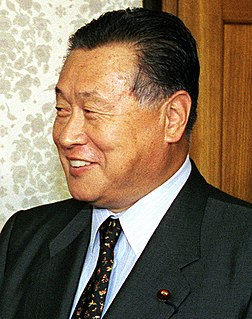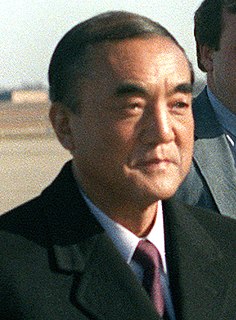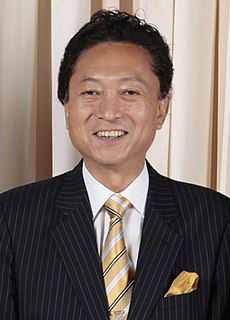
The House of Councillors is the upper house of the National Diet of Japan. The House of Representatives is the lower house. The House of Councillors is the successor to the pre-war House of Peers. If the two houses disagree on matters of the budget, treaties, or designation of the prime minister, the House of Representatives can insist on its decision. In other decisions, the House of Representatives can override a vote of the House of Councillors only by a two-thirds majority of members present.

Elections to the Shugi-In of the Japanese Diet were held on 25 June 2000.

The Social Democratic Party, also known as the Social Democratic Party of Japan and previously as the Japan Socialist Party, is a political party that at various times advocated the establishment of a socialist Japan until 1996. Since its reformation and name change in 1996, it has defined itself as a social-democratic party.
The Japanese political process has three types of elections: general elections to the House of Representatives held every four years, elections to the House of Councillors held every three years to choose one-half of its members, and local elections held every four years for offices in prefectures, cities, and villages. Elections are supervised by election committees at each administrative level under the general direction of the Central Election Administration Committee, an attached organization to the Ministry of Internal Affairs and Communications (MIC). The minimum voting age in Japan's non-compulsory electoral system was reduced from twenty to eighteen years in June 2016. Voters must satisfy a three-month residency requirement before being allowed to cast a ballot.

Delaware's at-large congressional district is a congressional district that includes the entire U.S. state of Delaware.

The 1968 United States Senate elections were elections for the United States Senate which coincided with the presidential election. Although Richard Nixon won the presidential election narrowly, the Republicans picked up five net seats in the Senate. Republicans would gain another seat after the election when Alaska Republican Ted Stevens was appointed to replace Democrat Bob Bartlett.

The 1942 United States House of Representatives elections was held in the middle of President Franklin D. Roosevelt's third term.

Maryland's 8th congressional district stretches from the northern Washington, D.C. suburbs north towards the Pennsylvania border. The district is currently represented by Democrat Jamie Raskin.

Results of the 1979 general election in Japan for the House of Representatives. A total of 511 seats were contested:

General elections were held in Japan on 22 June 1980. They were the result of a vote of no confidence brought by the Japan Socialist Party (JSP) on 16 May regarding corruption and rises in public utility charges as reasons for the House of Representatives of Japan to withdraw its backing from the government.

Floyd James Fithian was an American politician who was a member of the United States House of Representatives from Indiana. A member of the Democratic Party, Fithian represented Indiana's 2nd congressional district from 1975 into 1983.

The Japanese general election, 1986 was an election held in Japan on July 6, 1986, for the House of Representatives.

A general election for the Japanese House of Representatives was held on August 30, 2009. The opposition Democratic Party (DPJ) defeated the ruling coalition in a sweeping victory, winning 221 of the 300 electoral districts and receiving 42.4% of the proportional block votes for another 87 seats, a total of 308 seats to only 119 for the LDP.

The 32nd Pennsylvania House of Representatives District is in southwestern Pennsylvania and has been represented by Anthony M. DeLuca since 1983.

The 184th Pennsylvania House of Representatives District is located in Philadelphia and has been represented since 1993 by William F. Keller.
Events in the year 1983 in Japan.

The 1982 United States Senate election in Indiana was held on November 2, 1982. Incumbent Republican United States Senator Richard Lugar faced Democratic United States Representative Floyd Fithian in the general election. Lugar won with a margin of 53% of the vote, compared to Fithian's 46%.

The 1982 Minnesota House of Representatives election was held in the U.S. state of Minnesota on November 2, 1982, to elect members to the House of Representatives of the 73rd Minnesota Legislature. A primary election was held on September 14, 1982.

The Japanese National Proportional Representation Block, known in Japan as the House of Councillors proportional district is an electoral district for the House of Councillors, the upper house of the National Diet of Japan. It consists of the whole nation and elects 48 members per election, 96 in total, by D'Hondt method proportional representation (PR).




















